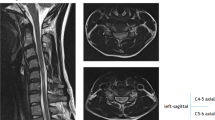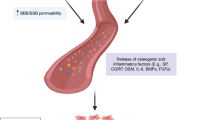Abstract
Study design:
The study was designed as a case report.
Objective:
The objective of this study was to report an unusual case of bilateral neurogenic heterotopic ossification of the hands in a patient with spinal cord injury.
Setting:
Physical Medicine and Rehabilitation department in Sale, Morocco.
Methods:
A 47-year-old male patient with C5 quadriparesis was admitted in our department for rehabilitation. He had severe spasticity, characterized by extensors predominance in the upper extremities, and an aspect of pudgy fingers at the proximal phalanges in both hands.
Results:
A plain radiograph of hands demonstrated ossification parallel to the proximal phalanx of the third and fourth digits on the right and of the second and third digits on the left. Serum alkaline phosphatase rate was increased. The diagnosis of heterotopic ossification of hands was retained.
Conclusion:
Neurogenic heterotopic ossification of hands can occur in quadriplegic patients. Finger extensors spasticity might help toward its development.
Similar content being viewed by others
Introduction
Neurogenic heterotopic ossification (NHO) is the formation of mature lamellar bone in locations in which bone normally does not exist, usually the soft tissues. It is a frequent complication following central nervous system disorders such as spinal cord injury (SCI). It usually involves large joints. We report a case of rare localization in the digits of the hands.
To our knowledge, our case is the fourth to report NHO of the hand in patients with SCI. There is also only one previous report, which describes NHO affecting both hands in spinal cord injured patients.1 Furthermore, it's the first case to report NHO of the hand in a patient with finger extensors spasticity.
Case report
A 47-year-old patient was hospitalized for rehabilitation of a C5 quadriparesis that had occurred 6 months ago following traumatic C3–C4 disc herniation.
Clinical examination on admission found a C5 American Spinal Injury Association scale C quadriparesis, important spasticity characterized by flexors predominance in the lower extremities graded 3/5 on the modified Ashworth scale and extensors predominance in the upper extremities, especially the extensors of fingers graded 4/5 (Figure 1). He also had a sacral pressure ulcer.
The examination also found an aspect of painless pudgy fingers at the proximal phalanges of digits in his hands with swelling from metacarpal–phalangeal joints to proximal interphalangeal joints (Figure 2). He had total loss of functional grasp in both the hands.
The differential diagnosis of these pudgy fingers was between arthritis (especially rheumatoid arthritis or spondylarthropathy) and NHO. Serum alkaline phosphatase rate was increased at 240 U l−1 (normal range: 50–136 U l−1). Sedimentation rate was at 16 mm. Serum calcium level was normal at 88 mg l−1 (normal range: 85–101 mg l−1). Measurement of 24-h prostaglandin E2 urinary excretion was not performed. Plain radiograph of hands, performed 3 weeks later, demonstrated ossification parallel to the proximal phalanx of the third and fourth digits on the right and the second and third digits on the left (Figure 3). There was also ossification in the metacarpo–phalangeal joints third on the right, second and third on the left. Joint ultrasonography of the hands did not show any effusion or synovitis.
The diagnosis of NHO of hands was retained. Owing to economical considerations, treatment with Indomethacin was introduced in addition to joint mobilization. The patient was lost to follow-up after discharge from the hospital.
Discussion
NHO occurs in 10–53% of patients with SCI. It always occurs below the level of neurological lesion. The most frequent involvement areas are large joints such as hips, knees, shoulders and elbows. It has exceptionally been described in the hands. The precise physiopathology is still unknown. NHO is generally diagnosed between 1–6 months post injury.2
In 1981, Lynch et al.3 described the first case of NHO of the hand after SCI. It concerned a 27-year-old patient with traumatic C5 quadriplegia, who developed acute swelling and loss of range of motion in both the hands at 2 months after injury. Bone scan demonstrated increased uptake in many joints of the left hand. At 1 month later, plain radiographs showed calcific densities adjacent to the midshaft of the proximal phalanx of the left index finger. Passive range of motion of the hand and a tenodesis splint permitted decrease in swelling and improvement in range of motion.
In the same year, Hendersen and Reid1 reported two cases of NHO in hands. One case was of a patient with SCI. It concerned a 40-year-old man with traumatic C5 tetraparesia, presenting NHO of both hands. Clinical signs had started at 2 weeks of evolution. NHO of proximal interphalangeal joints was diagnosed radiologically in the sixth month. The treatment was surgical for each hand separately.
In 1992, Meythaler et al.4 reported the case of a 44-year-old man with C5-traumatic SCI who developed NHO, involving the extensor tendons of one hand. NHO was discovered 4 months after the injury and it involved the extensor sheaths of the second, third and fourth digits, from the metacarpal–phalangeal joint to the proximal interphalangeal joint. Despite treatment with etidronate sodium and with aggressive range of motion exercises, he lost some functional grasp.
SCI was traumatic in all the cases reported and also in our case. The localization parallel to long bones seems to be frequent in hands.3, 4
Many risk factors have been evoked to explain the occurrence of NHO: the degree of completeness of lesion, presence of pressure ulcers, urinary tract infections or renal stones, deep veinous thrombosis, severe spasticity and trauma.2, 5 Our patient had two risk factors: spasticity and pressure ulcer.
Spasticity usually predominates in the anti-gravity muscles: upper limb flexors and lower limbs extensors. Our patient had finger extensor spasticity, which is exceptional. This spasticity majored the loss of functional grasp observed in our case.
Patients with finger extensor spasticity should be considered with high risk of NHO of the hands. Non-steroidal anti-inflammatory drugs can be administrated as early prophylaxis after SCI. Early identification and adequate treatment of finger extensor spasticity associated with regular and cautious mobilization of the small peripheral joints of the hands might be beneficial.2, 6
The early diagnosis is extremely important in the treatment of NHO of the hands. It should be carried out by a regular clinical assessment, bone scanning and measurement of the 24-h prostaglandin E2 urinary excretion.2, 6 Once NHO is diagnosed, biphosphonates have the strongest supportive evidence.6 Surgical resection of NHO is advised after a delay of 12–18 months. It is indicated for improvement of joint motion, reduction of spasms and prevention of pressure ulcers.2
NHO can involve the hands in spinal cord injured patients. The clinical presentation of our patient was atypical, in that there was spasticity in extensors of the digits and thumb, and NHO developed bilaterally and was parallel to the long bones of the hands. We suggest that spasticity of digits extensors might help toward the development of NHO of hands. More research is needed to clarify the mechanism of occurrence of NHO.
References
Henderson HP, Reid DA . Para-articular ossification in the hand. Hand 1981; 13: 239–245.
van Kuijk AA, Geurts AC, van Kuppevelt HJ . Neurogenic heterotopic ossification in spinal cord injury. Spinal Cord 2002; 40: 313–326.
Lynch C, Pont A, Weingarden SI . Heterotopic ossification in the hand of a patient with spinal cord injury. Arch Phys Med Rehabil 1981; 62: 291–293.
Meythaler JM, Tuel SM, Cross LL, Mathew MM . Heterotopic ossification of the extensor tendons in the hand associated with traumatic spinal cord injury. J Am Paraplegia Soc 1992; 15: 229–231.
Lal S, Hamilton BB, Heinemann A, Betts HB . Risk factors for heterotopic ossification in spinal cord injury. Arch Phys Med Rehabil 1989; 70: 387–390.
Teasell RW, Mehta S, Aubut JL, Ashe MC, Sequeira K, Macaluso S, et al., SCIRE Research Team. A systematic review of the therapeutic interventions for heterotopic ossification after spinal cord injury. Spinal Cord 2010; 48: 512–521.
Author information
Authors and Affiliations
Corresponding author
Ethics declarations
Competing interests
The authors declare no conflict of interest.
Rights and permissions
About this article
Cite this article
Bendeddouche, I., Aissaoui, N. & Hajjaj-Hassouni, N. Neurogenic heterotopic ossification of the hands in a patient with spinal cord injury: a case report. Spinal Cord 49, 1079–1081 (2011). https://doi.org/10.1038/sc.2010.191
Received:
Revised:
Accepted:
Published:
Issue Date:
DOI: https://doi.org/10.1038/sc.2010.191
Keywords
This article is cited by
-
Heterotopic Ossification of the Finger Following Closed Blunt Trauma
Journal of Hand and Microsurgery (2016)






